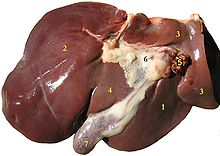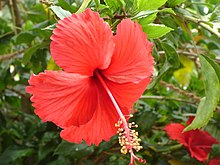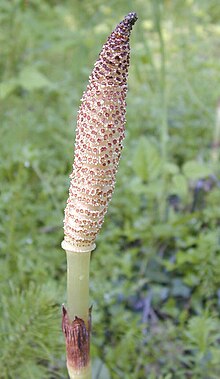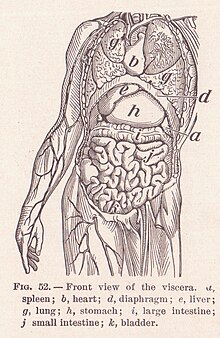Organ (biology)
| Organ | |
|---|---|
 Many of the internal organs of the human body | |
| Details | |
| System | Organ systems |
| Identifiers | |
| Greek | Οργανο |
| FMA | 67498 |
| Anatomical terminology | |
In a multicellular
An organ's tissues can be broadly categorized as
The number of organs in any organism depends on the definition used. By one widely adopted definition, 79 organs have been identified in the human body.[4]
Animals

Except for
- .
- .
- adrenals, i.e., adrenal glands.
- .
- .
- of birds.
- Muscular system: movement with muscles.
- Nervous system: collecting, transferring and processing information with brain, spinal cord and nerves.
- .
- .
- Skeletal system: structural support and protection with bones, cartilage, ligaments and tendons.
Viscera
In the study of
Origin and evolution

The organ level of organisation in
More complex animals are composed of different organs, which have evolved over time. For example, the liver and heart evolved in the chordates about 550-500 million years ago, while the gut and brain are even more ancient, arising in the ancestor of vertebrates, insects, molluscs, and worms about 700-650 million years ago.
Given the ancient origin of most vertebrate organs, researchers have looked for model systems, where organs have evolved more recently, and ideally have evolved multiple times independently. An outstanding model for this kind of research is the placenta, which has evolved more than 100 times independently in vertebrates, has evolved relatively recently in some lineages, and exists in intermediate forms in extant taxa.[11] Studies on the evolution of the placenta have identified a variety of genetic and physiological processes that contribute to the origin and evolution of organs, these include the re-purposing of existing animal tissues, the acquisition of new functional properties by these tissues, and novel interactions of distinct tissue types.[11]
Plants


The study of plant organs is covered in
The vegetative organs are essential for maintaining the life of a plant. While there can be 11 organ systems in animals, there are far fewer in plants, where some perform the vital functions, such as
Society and culture
Many societies have a system for
There is considerable interest throughout the world in creating laboratory-grown or artificial organs.[citation needed]
Organ transplants
Beginning in the 20th century[13] organ transplants began to take place as scientists knew more about the anatomy of organs. These came later in time as procedures were often dangerous and difficult.[14] Both the source and method of obtaining the organ to transplant are major ethical issues to consider, and because organs as resources for transplant are always more limited than demand for them, various notions of justice, including distributive justice, are developed in the ethical analysis. This situation continues as long as transplantation relies upon organ donors rather than technological innovation, testing, and industrial manufacturing.[citation needed]
History

This section needs expansion. You can help by adding to it. (February 2018) |
The English word "organ" dates back to the twelfth century and refers to any musical instrument. By the late 14th century, the musical term's meaning had narrowed to refer specifically to the keyboard-based instrument. At the same time, a second meaning arose, in reference to a "body part adapted to a certain function".[15]
Plant organs are made from tissue composed of different types of tissue. The three tissue types are ground, vascular, and dermal.[16] When three or more organs are present, it is called an organ system.[17]
The adjective This practice remains an important ritual in some remote, tribal societies.
The term "visceral" is contrasted with the term "parietal", meaning "of or relating to the wall of a body part, organ or cavity"[9] The two terms are often used in describing a membrane or piece of connective tissue, referring to the opposing sides.[19]
Antiquity
Aristotle used the word frequently in his philosophy, both to describe the organs of plants or animals (e.g. the roots of a tree, the heart or liver of an animal), and to describe more abstract "parts" of an interconnected whole (e.g. his logical works, taken as a whole, are referred to as the Organon).[20]
Some alchemists (e.g.
| Planet | Organ |
|---|---|
| Sun | Heart |
| Moon | Brain |
| Mercury | Lungs |
| Venus | Kidneys |
| Mars | Gall bladder |
| Jupiter | Liver |
| Saturn | Spleen |
| Element | Yin/yang | Organ |
|---|---|---|
| Wood | yin | liver |
| yang | gall bladder | |
| Fire | yin | heart |
| yang | small intestine / san jiao
| |
| Earth | yin | spleen |
| yang | stomach | |
| Metal | yin | lungs |
| yang | large intestine | |
| Water | yin | kidneys |
| yang | bladder |
The Chinese associated the five elements with the five planets (Jupiter, Mars, Venus, Saturn, and Mercury) similar to the way the classical planets were associated with different metals. The yin and yang distinction approximates the modern notion of solid and hollow organs.
See also
References
- ISBN 978-0-07-128366-3.[page needed]
- ISBN 0199141959.
- ^ "Botany/Plant structure – Wikibooks, open books for an open world". en.wikibooks.org. Archived from the original on 2018-02-07. Retrieved 2018-02-06.
- ^ "New organ named in digestive system". BBC News. 2017. Archived from the original on 2018-03-24. Retrieved 2018-02-05.
- ^ Bell, Daniel J. "Viscera | Radiology Reference Article | Radiopaedia.org". Radiopaedia.
- ^ Bell, Daniel J. "Solid and hollow abdominal viscera | Radiology Reference Article | Radiopaedia.org". Radiopaedia. Retrieved 24 November 2021.
- ^ "Biology of the Heart – Heart and Blood Vessel Disorders". MSD Manual Consumer Version. Retrieved 24 November 2021.
- ^ "Medical Definition of SPLANCHNOLOGY". www.merriam-webster.com. Retrieved 25 November 2021.
- ^ a b "Parietal – Learning brain structure, function and variability from neuroimaging data". team.inria.fr. Archived from the original on 2018-02-10. Retrieved 2018-02-10.
- ^ "Thoracic cavity". Amboss. Archived from the original on 21 July 2019. Retrieved 8 September 2019.
- ^ S2CID 32213223.
- ^ "The Plant Body | Boundless Biology". courses.lumenlearning.com. Archived from the original on 2019-01-21. Retrieved 2019-03-19.
- ^ "Timeline of Historical Events and Significant Milestones". Organ Donor Government Web. Archived from the original on 19 January 2019. Retrieved 19 March 2019.
- ^ "transplant | Definition, Types, & Rejection". Encyclopedia Britannica. Archived from the original on 2019-03-27. Retrieved 2019-03-19.
- ^ "organ (n.)". Online Etymology Dictionary. Archived from the original on 1 May 2019. Retrieved 22 March 2019.
- ^ "Plant Development I: Tissue differentiation and function". Biology 1520 (Georgia Tech). Georgia Tech. Archived from the original on 3 September 2019. Retrieved 8 September 2019.
- ^ "Organ System – Definition and Examples | Biology Dictionary". Biology Dictionary. 2016-10-31. Archived from the original on 2018-02-10. Retrieved 2018-02-10.
- ISBN 0415311292.
- ^ "Thoracic cavity". Amboss. Archived from the original on 21 July 2019. Retrieved 8 September 2019.
- ^ Lennox, James (31 Jan 2017). "Aristotle's Biology". Plato. Stanford University. Archived from the original on 7 May 2019. Retrieved 23 March 2019.
Section 2: Aristotle's Philosophy of Science
- from the original on 2021-08-02. Retrieved 2021-08-02.
External links
 Media related to Organs (anatomy) at Wikimedia Commons
Media related to Organs (anatomy) at Wikimedia Commons
